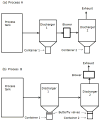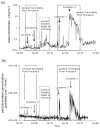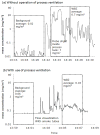Exposure controls for nanomaterials at three manufacturing sites
- PMID: 24918905
- PMCID: PMC4535687
- DOI: 10.1080/15459624.2014.930559
Exposure controls for nanomaterials at three manufacturing sites
Abstract
Because nanomaterials are thought to be more biologically active than their larger parent compounds, careful control of exposures to nanomaterials is recommended. Field studies were conducted at three sites to develop information about the effectiveness of control measures including process changes, a downflow room, a ventilated enclosure, and an enclosed reactor. Aerosol mass and number concentrations were measured during specific operations with a photometer and an electrical mobility particle sizer to provide concentration measurements across a broad range of sizes (from 5.6 nm to 30 μm). At site A, the dust exposure and during product harvesting was eliminated by implementing a wait time of 30 -min following process completion. And, the dust exposure attributed to process tank cleaning was reduced from 0.7 to 0.2 mg/m3 by operating the available process ventilation during this task. At site B, a ventilated enclosure was used to control dust generated by the manual weigh-out and manipulation of powdered nanomaterials inside of a downflow room. Dust exposures were at room background (under 0.04 mg/m3 and 500 particles/cm3) during these tasks however, manipulations conducted outside of the enclosure were correlated with a transient increase in concentration measured at the source. At site C, a digitally controlled reactor was used to produce aligned carbon nanotubes. This reactor was a closed system and the ventilation functioned as a redundant control measure. Process emissions were well controlled by this system with the exception of increased concentrations measured during the unloading of the product. However, this emission source could be easily controlled through increasing cabinet ventilation. The identification and adoption of effective control technologies is an important first step in reducing the risk associated with worker exposure to engineered nanoparticles. Properly designing and evaluating the effectiveness of these controls is a key component in a comprehensive health and safety program.
Keywords: airborne contaminants; control evaluation; engineered nanomaterials; engineering controls; hazard prevention.
Figures








Similar articles
-
Modeled effectiveness of ventilation with contaminant control devices on indoor air quality in a swine farrowing facility.J Occup Environ Hyg. 2014;11(7):434-49. doi: 10.1080/15459624.2013.875186. J Occup Environ Hyg. 2014. PMID: 24433305 Free PMC article.
-
NTP Toxicity Study Report on the atmospheric characterization, particle size, chemical composition, and workplace exposure assessment of cellulose insulation (CELLULOSEINS).Toxic Rep Ser. 2006 Aug;(74):1-62, A1-C2. Toxic Rep Ser. 2006. PMID: 17160106
-
Field evaluation of an engineering control for respirable crystalline silica exposures during mortar removal.J Occup Environ Hyg. 2007 Nov;4(11):875-87. doi: 10.1080/15459620701665720. J Occup Environ Hyg. 2007. PMID: 17917951
-
Ultrafine particles emitted by flame and electric arc guns for thermal spraying of metals.Ann Occup Hyg. 2010 Aug;54(6):607-14. doi: 10.1093/annhyg/meq052. Epub 2010 Aug 4. Ann Occup Hyg. 2010. PMID: 20685717 Review.
-
Buildings operations and ETS exposure.Environ Health Perspect. 1999 May;107 Suppl 2(Suppl 2):313-7. doi: 10.1289/ehp.99107s2313. Environ Health Perspect. 1999. PMID: 10375293 Free PMC article. Review.
Cited by
-
The Life Cycle of Engineered Nanoparticles.Adv Exp Med Biol. 2017;947:41-69. doi: 10.1007/978-3-319-47754-1_3. Adv Exp Med Biol. 2017. PMID: 28168665 Review.
-
Review of techniques and studies characterizing the release of carbon nanotubes from nanocomposites: Implications for exposure and human health risk assessment.J Expo Sci Environ Epidemiol. 2018 May;28(3):203-215. doi: 10.1038/jes.2017.6. Epub 2017 May 31. J Expo Sci Environ Epidemiol. 2018. PMID: 28561036 Review.
-
Alzheimer's, Parkinson's, Frontotemporal Lobar Degeneration, and Amyotrophic Lateral Sclerosis Start in Pediatric Ages: Ultrafine Particulate Matter and Industrial Nanoparticles Are Key in the Early-Onset Neurodegeneration: Time to Invest in Preventive Medicine.Toxics. 2025 Feb 28;13(3):178. doi: 10.3390/toxics13030178. Toxics. 2025. PMID: 40137505 Free PMC article. Review.
-
Toxicology data of graphene-family nanomaterials: an update.Arch Toxicol. 2020 Jun;94(6):1915-1939. doi: 10.1007/s00204-020-02717-2. Epub 2020 Apr 2. Arch Toxicol. 2020. PMID: 32240330 Review.
-
Performance evaluation of mobile downflow booths for reducing airborne particles in the workplace.J Occup Environ Hyg. 2017 Nov;14(11):839-852. doi: 10.1080/15459624.2017.1335404. J Occup Environ Hyg. 2017. PMID: 28644723 Free PMC article.
References
-
- NIOSH. Approaches to Safe Nanotechnology: Managing the Health and Safety Concerns Associated with Engineered Nanomaterials. Cincinnati, Ohio: 2009.
-
- Schulte P, Geraci C, Zumwalde R, Hoover M, Kuempel E. Occupational risk management of engineered nanoparticles. Journal of Occupational and Environmental Hygiene. 2008;5(4):239–249. - PubMed
-
- Kuempel ED, Geraci CL, Schulte PA. Risk Assessment and Risk Management of Nanomaterials in the Workplace: Translating Research to Practice. Annals of Occupational Hygiene. 2012;56(5):491–505. - PubMed
-
- Ramachandran G, Ostraat M, Evans DE, Methner MM, O’Shaughnessy P, D’Arcy J, et al. A Strategy for Assessing Workplace Exposures to Nanomaterials. Journal of Occupational and Environmental Hygiene. 2011;8(11):673–685. - PubMed
-
- Schulte P, Murashov V, Zumwalde R, Kuempel E, Geraci C. Occupational exposure limits for nanomaterials: state of the art. Journal of Nanoparticle Research. 2010;12(6):1971–1987.
Publication types
MeSH terms
Substances
Grants and funding
LinkOut - more resources
Full Text Sources
Other Literature Sources
Medical
